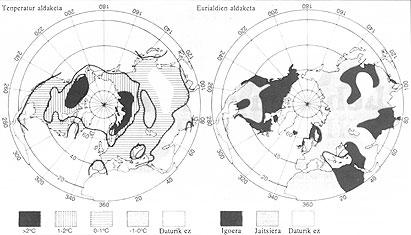The greenhouse effect, what is it?
1989/01/01 Gribbin, John Iturria: Elhuyar aldizkaria
Being surrounded by an air mattress, the Earth is “quite temperate”. Being “temperate enough” means that the temperature of the Earth is between 0ºC and 100ºC, that is, while the water remains liquid. Thus, if we compare the temperatures of our planet with those of the Moon, we will see that the Earth's atmosphere has responsibility.
The Moon and Earth are about the same distance from the Sun—
Solar System Heat Source— that,
But the Moon is a “planet” without atmosphere. On the Moon without air, the temperature rises to 100°C in solar boilers and drops to -150ºC at night.
The average temperature of the lunar surface is -18ºC. At this temperature, the energy emitted by the Moon into space equals that it receives from the Sun. If the earth had no air mattress and was a stone ball like the moon, the average surface temperature would be -18ºC. The average surface temperature of our planet is 15ºC. The air mattress keeps the temperature of our planet 33°C warmer than it would.
But how does that happen? The energy of the Sun radiated mainly in the visible part of the spectrum, in a band of 0.4 to 0.7 microns. This short-wavelength radiation and infrared traverse the Earth without being absorbed atmospheres — although clouds reflect a part of space — and heat terrestrial and marine surfaces. 7% of solar energy is radiated in shorter radiations of 0.4 microns, specifically in the ultraviolet zone. At the other end of the spectrum, above 0.7 microns, infrared radiation occurs. This infrared energy is exactly the same as you feel at the height of your home radiator.
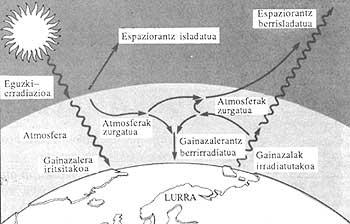
Earth mattress
The wavelength to which a hot object will radiate mostly depends on the temperature of the hot object. The surface temperature of the Sun is about 6,000ºC, to which corresponds the auditory band radiation. The surface of the Earth, tempered by solar radiation, has a temperature of few degrees Celsius and, therefore, the radiation is infrared, mainly between 4 and 100 microns.
Water vapor violently absorbs in the band of 4-7 microns and carbon oxide (IV) in the band of 13-19 microns. Thus, between 7-13 microns is the window, from where more than 70% of the energy emanating from the earth's crust escapes to space.
The infrared heat that leads to the temperate surface of the planet by the cause of absorption cannot freely escape into space and warms the innermost layer of the atomosphere, the troposphere. The air in the troposphere is temperate, so it is able to radiate heat to the ground and keep it warmer than there could be. That is the greenhouse effect.
As the amount of water vapor contained in air and carbon oxide (IV) and the amount of heat from the Sun remain constant, a balance is established. “Greenhouse gases” (carbon oxide, water vapor and others) in addition to absorbing infrared radiation, emit. By increasing the height the temperature of the troposphere decreases, so that each layer of the troposphere will absorb the energy that is below and pass it to that which is above it. Finally, the heat escapes to space at lower temperature. The total effect is the decrease of the infrared radiation to space. The surface temperature must increase to balance the energy that leads to Earth with the energy from the Sun.
The greenhouse effect heats the soil and air. The current concern about the greenhouse effect is that human actions are increasing the amount of carbon dioxide present in the atmosphere. Carbon dioxide emissions reinforce the greenhouse effect. Other gases currently originated by human action, anthropogenic gases, which absorb infrared energy in the 7-13 microns window that uses radiation to escape. The combined effect of these anthropogenic gases seems to produce in the coming decades a remarkable warming of the Earth.
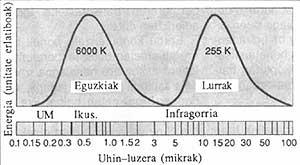
Enriched atmosphere
Knowledge of the greenhouse effect, XIX. Scientists have it since the mid-20th century. In 1863, British scientist John Tyndall exposed the behavior of water vapor as greenhouse gas in Philosophical Magazine. In 1890 the Swedish Svante Arrhenius and P. C. The American Chamberlain analyzed the problems that could cause the accumulation of carbon dioxide in the air due to the combustion of coal. Average air temperature of surface XX. In the first half of the 20th century there was a slight increase, from 0.25ºC to 1880 to 1940. But between 1940 and 1970 the world cooled to 0.2°C and the study of global warming did not become an interesting subject of study.
The situation changed when measurements of atmospheric carbon dioxide concentrations indicated that the concentration increased considerably. In the 1970s there was great interest in this subject and in the 19th century. They began to say that the doubling of the “natural” concentration of carbon dioxide of the 20th century would cause a Earth warming of 2ºC.
Between the 1970s and 1980s, at the same time as these predictions, the average temperature of the Earth increased by 0.3°C and seems to continue during the 1980s. The oldest data on temperatures are those of 1850. In 1987 it was the hottest and in 1988, according to the first six months, it can break the mark. It cannot be shown that this is only a consequence of the anthropogenic effect of the greenhouse. But the analysis of the problem has become a very interesting topic.
The exact determination of the amount of carbon dioxide present in the air began in Mauna Loa (Hawaii) and in the South Pole with the excuse of the International Geographic Year (1957-58). These two stations are important because they are away from sources of pollution and indicate the “well mixed” state of the atmosphere. In these two points the annual rhythm is appreciated. This rhythm is related to the seasonal change of vegetation covered by the land of the Northern Hemisphere. Terrestrial vegetation breathes carbon dioxide (during this cycle the Northern Hemisphere is responsible for the largest land masses being present). At this annual rate by the 1970s, the trend that marks the rise of carbon dioxide was clearly overlapping.
In 1957 the concentration of carbon dioxide in the atmosphere was 315 million parts (0.0315%). Today it is the fraction of 350 million (0.035%). The increase in carbon oxide (IV) is mainly due to the combustion of fossil fuels (especially coal), but part can be due to the dumping of tropical forests.
When a ton of carbon is burned, for example in the form of coal, four tons of carbon dioxide are produced by combining each carbon atom with two oxygen atoms in the air. In the early 1980s, 5 gigatons (5 billion tons, 5Gt) were burned per year, resulting in the injection into the atmosphere of 20Gt of carbon dioxide. However, the increase in the concentration of carbon dioxide in the atmosphere is due to less than half of what human activity generates.
About half of the carbon oxide (IV) we produce is absorbed into natural wells. Part of it will be occupied by vegetation, which grows more strongly in an environment with more carbon dioxide. In this word vegetation we also consider the marine plankton. Another part dissolves in the oceans.
Between 1850 and 1950 60 Gt of carbon was burned, mostly in the form of coal, when the industrial revolution was boiling. Today it takes only 12 years to burn this amount of carbon. The amount of carbon dioxide to be emitted into the atmosphere from today to the west will probably be the same as it burned between 1850-1950.
Researchers have set out in the 19th century. In the 20th century the natural concentration in the atmosphere was approximately 270 million parts. Once the air bubbles trapped in polar ice have been studied, similar concentrations have been measured for the time before the industrial revolution. The study of air bubbles in the Antarctic indicates that the concentration of carbon oxide in the last 10,000 years has remained constant.
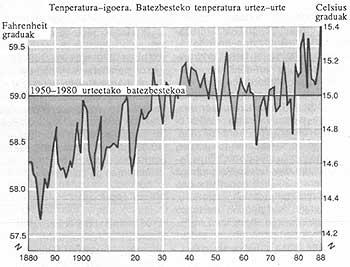
Climate change
XIX. Different computerized models on global climate change that may be due to the doubling of the carbon dioxide (CO2) concentration of the 20th century have given quite equal figures: most indicate an average temperature increase of 2ºC.
These computerized models also indicate that the temperature increase will be much higher than in the tropics already temperate in high latitudes. Changes will also occur in the directions of the prevailing winds and in the distribution of torrential rains. It is believed that the interior areas of the continents will dry as the greenhouse effect increases.
Extrapolating the current concentration increase, the doubling of the carbon dioxide concentration will occur around 2080. This estimate has not taken into account possible changes in the use of energy sources over the next century. The problem is in the current debate. However, we can use this number to measure the problem of carbon oxide (IV).
Other gases emitted into the atmosphere by human activity, such as ozone, methane, nitrogen oxides and fluorohydrocarbons, absorb in the infrared radiation window from 7 to 13 microns. Fluorohydrocarbons, in addition to being responsible for the holes being produced in the ozone layer in the Arctic and Antarctica, are very powerful greenhouse gases. A molecule of the most common fluorohydrocarbons produces the greenhouse effect of 10,000 carbon dioxide molecules.
Currently, the atmospheric concentration of methane is 1.7 million and is growing 1.2% annually. The cause of this increase is the work of rice bacteria and spills that occur in oil and gas deposits. Nitrogen oxides are 0.3 million parts in the atmosphere and their concentration is increasing 0.3% per year because the use of nitrogen fertilizers is spreading.
University of Chicago researcher Veerhabadrhan Ramanathan has turned the greenhouse effect of these gases into an equivalent of carbon dioxide and extrapolated its concentration by 2030. In his opinion, the sum of all these small contributions will be equal to that of carbon dioxide produced by human activity. In short, the anthropogenic greenhouse force will double. That is, the effective doubling of the carbon oxide (IV) concentration will occur in 2030, half a century ahead of what would mean a single increase in carbon dioxide.
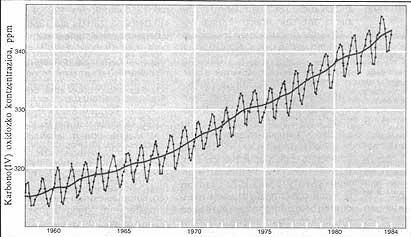
Climate problem
How will the event we have just described affect the world climate? Nobody can say it accurately, but to have some idea you can look at the weather trends that have existed during this century in different regions of the world, in the warm years and in the cold years. Researchers at the University of East Anglia in Britain have done this work. Data from the 50 years between 1925 and 1974 were analyzed and the five warmest and the five coldest were selected.
Temperatures in the regions near Arqui, between latitudes 65oI and 80oI, were first analyzed. This area includes Lapland, almost all of Finland, Iceland, northern Canada, Alaska and Northern Siberia. In this area, the difference between warm and cold extremes is 1.6ºC, but considering the Northern Hemisphere as a whole, this difference is 0.6ºC. If only winters are compared, the difference between ends is 1.8°C and 0.7°C in summer.
In addition, in the warm years the torrential rains will increase by 1-2%. This is to be expected, because in temperate years more water evaporates in the oceans. After this modest comparison in average global rainfall, the biggest changes that have occurred in specific regions are hidden. Lower rainfall in the USA, Europe, USSR and Japan. However, in India and the Middle East the precipitation has been higher.
This simple analysis cannot be used as a decisive model for shaping climate change that will involve global warming. However, it seems to confirm what the computerized models indicated (in high latitudes the temperature increase will be four times higher than the average). Similarly, it indicates that the weather schemes we use now do not work either.
Actually, the greenhouse effect is not bad. From the human point of view it is more appropriate than a new Ice Age. The problem is how humanity faces environmental change. The greenhouse effect makes the world change. Potential resource plans (agricultural plans, flood containment wall design, location of drinking water reservoirs, etc.) will be wrong. Climatologists exemplify the drought that has occurred last summer in the US. It does not seem that the greenhouse effect is solely responsible, since the summer of 1987 was as mild as that of 1988. But, whatever the cause of the drought, in North America the XXI. It can be an indicator of the possible decrease in precipitation as the century progresses.
The greenhouse effect should be taken into account in long-term planning. From this point and when choosing different types of energy (nuclear or not), it can become a political weapon. In fact, nuclear power is in this case clean from the point of view of environmental protection.

Gai honi buruzko eduki gehiago
Elhuyarrek garatutako teknologia




